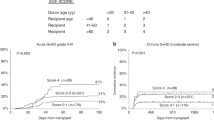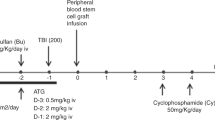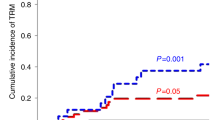Summary:
Older age has been linked to increased transplant-related mortality from graft-versus-host disease (GvHD). Depletion of T cells from stem cell grafts seems to protect from complications of GvHD particularly in older patients. After myeloablative conditioning, patients with haematological malignancies received allogeneic grafts from HLA identical siblings. For GvHD prophylaxis, PBPC grafts were treated ex vivo with anti-CD52, and therapeutic doses of cyclosporin until day +90. Survival of patients younger or older than the population age median was analysed. In all, 62 consecutive patients with a median age of 42.5 years were studied. Death was procedure related in 17% and from relapse of malignancy in five. At a median, follow-up is 662 (7–2316) days, 74% survive disease free. The rate of haematopoietic recovery and treatment-related mortality was similar in both groups. A total of 73% of 30 individuals in the younger group and 75% (P=0.8) in the older cohort survive at a median follow-up of 444 and 806 days (P=0.4). GvHD occurred in 13% and was the only adverse factor for survival (P<0.04). Myeloablative conditioning is well tolerated up to the age of 59 in patients receiving T-cell-depleted grafts. This information is useful to more precisely select patients who would benefit most from reduced intensity conditioning schedules.
This is a preview of subscription content, access via your institution
Access options
Subscribe to this journal
Receive 12 print issues and online access
$259.00 per year
only $21.58 per issue
Buy this article
- Purchase on Springer Link
- Instant access to full article PDF
Prices may be subject to local taxes which are calculated during checkout




Similar content being viewed by others
References
Klingemann HG, Storb R, Fefer A et al. Bone marrow transplantation in patients aged 45 years and older. Blood 1986; 67: 770–776.
Yanada M, Emi N, Naoe T et al. Allogeneic myeloablative transplantation for patients aged 50 years and over. Bone Marrow Transplant 2004; 34: 29–35.
Doney K, Hagglund H, Leisenring W et al. Predictive factors for outcome of allogeneic hematopoietic cell transplantation for adult acute lymphoblastic leukemia. Biol Blood Marrow Transplant 2003; 9: 472–481.
Valls A, Algara M, Marrugat J et al. Risk factors for early mortality in allogeneic bone marrow transplantation. A multivariate analysis on 174 leukaemia patients. Eur J Cancer 1993; 29A: 1523–1528.
Cutler C, Giri S, Jeyapalan S et al. Incidence of acute and chronic graft-versus-host disease after allogeneic peripheral blood stem cell and bone marrow transplantation: a meta-analysis. Blood 2000; 96: 205a.
Remberger M, Sundberg B . Cytokine production during myeloablative and reduced intensity therapy before allogeneic stem cell transplantation. Haematologica 2004; 89: 710–716.
Copelan EA, Penza SL, Theil KS et al. The influence of early transplantation, age, GVHD prevention regimen, and other factors on outcome of allogeneic transplantation for CML following BuCy. Bone Marrow Transplant 2000; 26: 1037–1043.
Greinix HT, Nachbaur D, Krieger O et al. Factors affecting long-term outcome after allogeneic haematopoietic stem cell transplantation for acute myelogenous leukaemia: a retrospective study of 172 adult patients reported to the Austrian Stem Cell Transplantation Registry. Br J Haematol 2002; 117: 914–923.
Bornhauser M, Storer B, Slattery JT et al. Conditioning with fludarabine and targeted busulfan for transplantation of allogeneic hematopoietic stem cells. Blood 2003; 102: 820–826. Epub 2003 Apr 03.
Giralt S, Estey E, Albitar M et al. Engraftment of allogeneic hematopoietic progenitor cells with purine analog-containing chemotherapy: harnessing graft-versus-leukaemia without myeloablative therapy. Blood 1997; 89: 4531–4536.
Ferrara JL, Deeg HJ . Graft-versus-host disease. N Engl J Med 1991; 324: 667–674.
Robinson SP, Goldstone AH, Mackinnon S et al. Chemoresistant or aggressive lymphoma following reduced-intensity allogeneic progenitor. an analysis from the lymphoma working group for blood and bone marrow transplantation. Blood 2002; 13: 4310–4316.
Hale G, Jacobs P, Wood L et al. CD52 antibodies for prevention of graft-versus-host disease and graft rejection following transplantation of allogeneic peripheral blood stem cells. Bone Marrow Transplant 2000; 26: 69–76.
Novitzky N, Thomas V, Hale G, Waldmann H . Campath-1 Abs ‘in the bag’ for hematological malignancies: The Cape Town experience. Cytotherapy 2004; 6: 172–181.
Hale G, Xia M-Q, Tighe HP et al. The CAMPATH-1 antigen (Cdw 52). Tissue Antigens 1990; 35: 118–127.
Novitzky N, Thomas V, Hale G, Waldman H . Ex vivo depletion of T-cells from BM grafts with CAMPATH 1G in acute leukemia: Graft vs Host disease and Graft vs Leukemia effect. Transplantation 1999; 67: 620–626.
Novitzky N, Rubinstein R, Hallett JM et al. Bone marrow transplantation depleted of T cells followed by repletion with incremental doses of donor lymphocytes for relapsing patients with chronic myeloid leukemia: a therapeutic strategy. Transplantation 2000; 69: 1358–1363.
Hickman RO, Buckner CD, Clift RA et al. A Modified right atrial catherter for access to the venous system in marrow transplant recipients. Surg Gynecol Obstet 1979; 148: 871–875.
Novitzky N, Rouskova A . Infectious complications following T-cell depleted hematopoietic stem-cell transplantation. Cytotherapy 2001; 3: 165–173.
Bern MM, Lokich JJ, Wallach SR et al. Very low doses of warfarin can prevent thrombosis in central venous catheters. A randomized prospective trial. Ann Intern Med 1990; 112: 423–428.
Sutherland DR, Anderson L, Keeney M et al. The ISHAGE guidelines for CD34+ cell determination by flow cytometry. J Hematother 1996; 5: 213–226.
Phillips J, Drumm A, Harrison P et al. Manufacture and quality control of CAMPATH-1 antibodies for clinical trials. Cytotherapy 2001; 3: 233–242.
Smyth LA, Witt CS, Christiansen FT et al. The MHC influences acute graft versus host disease in MHC matched adults undergoing allogeneic bone marrow transplantation. Bone Marrow Transplant 1993; 12: 351–355.
Atkinson K, Horowitz MM, Gale RP et al. Risk factors for chronic graft-versus-host disease after HLA-identical bone marrow transplantation. Blood 1990; 75: 2459–2464.
Greenberg PD, Stewart PS, Sullivan KM . Bone marrow transplantation in patients aged 45 years and older. Blood 1986; 67: 770–776.
Doney K, Fisher LD, Appelbaum FR et al. Treatment of adult acute lymphoblastic leukemia with allogeneic bone marrow transplantation. Multivariate analysis of factors affecting acute graft-versus-host disease, relapse, and relapse-free survival. Bone Marrow Transplant 1991; 7: 453–459.
Wagner JE, Zahurak M, Piantadosi S et al. Bone marrow transplantation of chronic myelogenous leukemia in chronic phase: evaluation of risks and benefits. J Clin Oncol 1992; 10: 779–789.
Gorin NC, Labopin M, Polge E et al. Acute leukaemia working party of the European cooperative group for blood and marrow transplantation (EBMT). Risk assessment in adult acute lymphoblastic leukaemia before early haemopoietic stem cell transplantation with a geno-identical donor: an easy clinical prognostic score to identify patients who benefit most from allogeneic haemopoietic stem cell transplantation. Leukemia 2003; 17: 1596–1599.
Davison GM, Novitzky N, Kline A et al. Immune reconstitution after allogeneic bone marrow transplantation depleted of T cells. Transplantation 2000; 69: 1341–1347.
Novitzky N, Davison GM, Hale G, Waldmann H . Immune reconstitution at 6 months following T-cell depleted hematopoietic stem cell transplantation is predictive for treatment outcome. Transplantation 2002; 74: 1551–1559.
Robello P, Cwynarski K, Vaughese M et al. Pharmacokinetics of CAMPATH-1H in BMT patients. Cytotherapy 2001; 3: 261–267.
Chakrabarti S, MacDonald D, Hale G et al. T-cell depletion with Campath-1H ‘in the bag’ for matched related allogeneic peripheral blood stem cell transplantation is associated with reduced graft-versus-host disease, rapid immune constitution and improved survival. Br J Haematol 2003; 121: 109–118.
Apperley JF, Jones L, Hale G et al. Bone marrow transplantation for patients with chronic myeloid leukaemia: T-cell depletion with Campath-1 reduces the incidence of graft-versus-host disease but may increase the risk of leukaemic relapse. Bone Marrow Transplant 1986; 1: 53–66.
Gomez-Nunez M, Martino R, Caballero MD et al. Elderly age and prior autologous transplantation have a deleterious effect on survival following allogeneic peripheral blood stem cell transplantation with reduced-intensity conditioning: results from the Spanish multicenter prospective trial. Bone Marrow Transplant 2004; 33: 477–482.
Hamaki T, Hamaki T, Kami M et al. Reduced-intensity stem cell transplantation from an HLA-identical sibling donor in patients with myeloid malignancies. Bone Marrow Transplant 2004; 33: 891–900.
Sayer HG, Kroger M, Beyer J et al. Reduced intensity conditioning for allogeneic hematopoietic stem cell transplantation in patients with acute myeloid leukemia: disease status by marrow blasts is the strongest prognostic factor. Bone Marrow Transplant 2003; 31: 1089–1095.
Levine JE, Uberti JP, Ayash L et al. Lowered-intensity preparative regimen for allogeneic stem cell transplantation delays acute graft-versus-host disease but does not improve outcome for advanced hematologic malignancy. Marrow Transplant 2003; 9: 189–197.
Nachbaur D, Larcher C, Kircher B et al. Risk for cytomegalovirus infection following reduced intensity allogeneic stem cell transplantation. Ann Hematol 2003; 82: 621–627.
Canals C, Martino R, Sureda A et al. Strategies to reduce transplant-related mortality after allogeneic stem cell transplantation in elderly patients: Comparison of reduced-intensity conditioning and unmanipulated peripheral blood stem cells vs a myeloablative regimen and CD34+ cell selection. Exp Hematol 2003; 31: 1039–1043.
Acknowledgements
We are very grateful for the dedication and care provided to our patients by the nursing and medical staff at Groote Schuur Hospital. We are also indebted to The Therapeutic Antibody Center at Oxford for supplying the antibody and Coleen Fredericks for secretarial assistance.
Author information
Authors and Affiliations
Corresponding author
Rights and permissions
About this article
Cite this article
Novitzky, N., Thomas, V., Hale, G. et al. Myeloablative conditioning is well tolerated by older patients receiving T-cell-depleted grafts. Bone Marrow Transplant 36, 675–682 (2005). https://doi.org/10.1038/sj.bmt.1705119
Received:
Accepted:
Published:
Issue Date:
DOI: https://doi.org/10.1038/sj.bmt.1705119
Keywords
This article is cited by
-
Reduced-intensity conditioning for severe aplasia using fludarabine and CY followed by infusion of ex vivo T-cell-depleted grafts leads to excellent engraftment and absence of GVHD
Bone Marrow Transplantation (2009)
-
Myeloablative unrelated cord blood transplantation for acute leukemia patients between 50 and 55 years of age: single institutional retrospective comparison with patients younger than 50 years of age
Annals of Hematology (2009)
-
Novel approaches in allogeneic stem cell transplantation
Current Oncology Reports (2006)



